I’ve had the bruises, smashed fingers, and errant whacks to know that a good tool is hard to find.
Luckily, my search for the right hatchet is over; I’ve checked out the Estwing Sportsman’s Axe and put it through a few weeks of testing.
Keep reading and you’ll see why it’s earned the coveted Two-Bruised Thumbs Up.
Specs and Buying Options
Total Length: 14″ | Steel: 1055 Carbon Steel | Weight: 1.86lb | Made In USA
Primal Rating: 4.5 (out of 5)
Check On AmazonCheck On BladeHQ
Felt Right, Right Out of the Box
Well, it was shipped in a large yellow envelope, not a box. Soon as I got my hands on it I was (mostly) in love. Perfectly contoured leather washers surround the handle, and the solid weight of this full-tang hatchet is reassuring more than it is cumbersome.
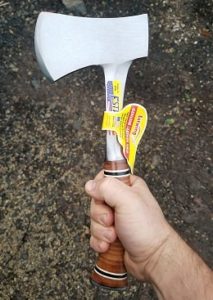
The only complaint about that first feel is the balance of the Estwing. The head and blade are heavy and, when you’re holding the hatchet still it feels ready to tip over out of your grip. The question arises, How often are you going to hold the hatchet when you aren’t chopping?
Good point, but it’s still a noticeable feeling when you’re holding it in hand.
The stickers that came attached to the neck of the hatchet seem like Estwing does NOT want them removed. They’re still stuck to the neck of this thing until I get some nail polish remover to remove what adhesive is left.
The hatchet comes with a handy little sheath; some pictures online show a lovely leather sheath, but I received one with a nylon sheath. It looks pretty good, but I’m a sucker for leather over nylon any day. Slightly disappointing.
Its blade wasn’t too sharp right away, but it wasn’t dull either. On the surface, this seems like a drawback, but a hatchet and axe blade does not need the same edge as a knife. Knives require a razor-sharp edge to cut through material at a molecular level, whereas axes and hatchet concentrate their force in one area.
I gave the cutting edge a quick once over with a whetstone before I used it, read on to see why that was a mistake.
That First Whack
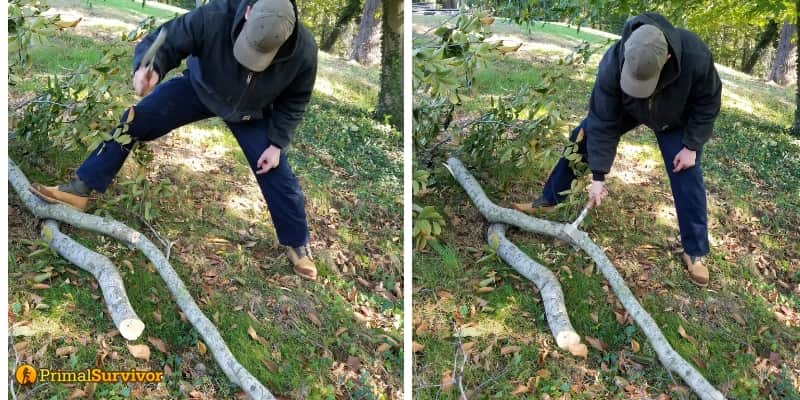
I work as a gardener on huge wooded estates, so I have easy access to a variety of broken limbs and roots to chop through. Lucky for this review, I was sent to remove large branches from a beech tree that suffered some storm damage. Beech is a pretty dense wood according to the Engineering Tool Box, so this was a perfect test for my new hatchet.
Popped this bad boy out of the sheath, felt it in my hands, and went whack, whack, WHOA!
The blade skipped right from the wood and banged into my shin. I was wearing jeans and am too stubborn to admit to an injury, so let’s just say this was an unpleasant sensation. It left no mark and didn’t draw blood, but it forced me to be way more cautious on my next swings.
I attribute this skipping of the blade to my foolish sharpening of the thing combined with the density of beech, not to the hatchet itself.
The rest of the chopping was a vision of beauty. That almost awkward imbalance I felt when first holding the hatchet disappeared when it was in action. It eats through wood like Homer Simpson through a box of donuts.
Watch this short video for a demonstration of its chopping prowess;
How Is That Impact?
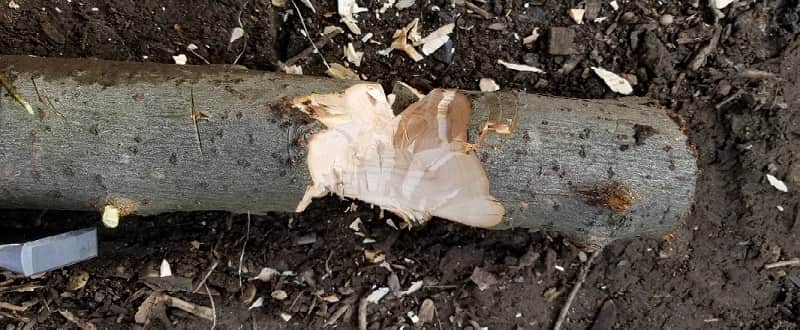
Typically I’ve used a handsaw for large limbs because chopping is tiring and time-consuming, but the Estwing is my new go-to for this kind of clean-up.
Unlike other hatchets, I’ve used this one fires through the workload, and the additional weight on the head results in extra chips of wood flying everywhere.
The solid, one-piece construction resulted in zero impact in my wrist and elbow, too, so I never felt that terrible lightning bolt through the joints I’m used to from chopping wood. The handle felt comfortable in my hand, too… mostly.
The Handle
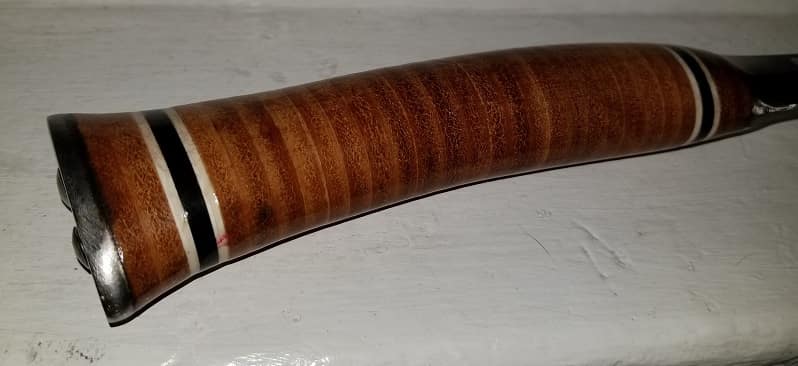
When I wore my gloves to chop the handle was secure in my grip and didn’t slide or budge. But when I removed my gloves to see how this lacquered leather handle felt in my bare hands while chopping I was disappointed.
The handle slides around in my grip uncomfortably. Gloves are always a safe choice, but I like to use tools barehanded whenever I can. This too-smooth handle is a bit of a hangup for me.
Solution for the Handle
I’ve yet to give this a shot but have read many users with the suggestion of sanding away the lacquered coating and applying coat after coat of neatsfoot oil (Amazon Link).
Not only does this reportedly improve the feel of the leather washers on the handle, but it also helps to preserve those discs from drying out and cracking over the years.
I’ll update this article after I’ve given the Estwing more of a beating and have put this lacquer removal to the test.
That Nylon Sheath
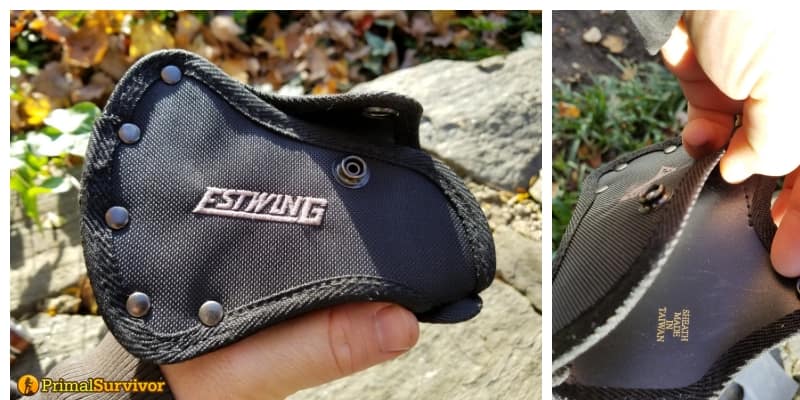
So I’ve chop, chop, chopped my way through an eight-inch-thick beech branch, knocked it into manageable pieces… and now I’ve got to carry it back to my work truck. We’ve got a good hike back to where we load up, and I do not want to do it twice after carrying a heavy load of wood.
The best solution is to put this nylon sheath on my belt and load the hatchet in.
Stuff on my belt drives me nuts, simple as that. It bumps into my leg or catches on things. I recognize the utility of tools ready on my hip is hugely beneficial, but I don’t need to like it.
To date, there are two items I don’t mind being attached to my belt; my Felco pruners, and this Estwing axe.
Maybe it’s the balance of the thing or the angles, but I didn’t even notice the Estwing on my hip. I even stopped once to double-check it was still there! Truly effortless carrying. I went for a very short run with it on my hip and found it bounces around less when it’s positioned on the front of my hips rather than closer to my butt.
It’s a little awkward to get in or out of the sheath, but that’ll be remedied with practice and use. For a nylon sheath… it’s pretty good, and that’s about as good an endorsement I can provide for anything nylon.
So the Hatchet Can Chop Wood, What Else Can It Do?
Wait, you want a hatchet for something besides chopping and splitting wood? Get yourself a different tool, partner. All joking aside, a tool with multiple uses is a worthwhile piece of gear. The peace of mind knowing you’re covered if you lose or break a piece of gear is invaluable.
So, what else can this thing do?
It can do quite a bit and does it all well. Check out the following tests I’ve performed, in order, after using this hatchet to chop through beech, dogwood, and unidentified but awfully dense roots.
It’s Hammer Time
Unlike most hatchets, the Estwing has a square butt and is perfect for nailing tent stakes through the ground, or for other general hammering purposes.
I used it to bang in the finishing nails of a bookcase my wife and I put together and am happy to report no crushed thumbs or dented wood.
I gave it another test, though; the “Can It Smash a Rock” test?
Why the heck would you want to smash a rock?! I’ve built fireplaces in the woods a thousand times and have smashed plenty of rocks to find the right size I need. Keep in mind I’d never do this to a round stone, but a piece of flat stone that has an awkward protrusion on it? Heck yes I’m gonna smash that rock.
The Estwing has a lot of force for this work, but it got the job done! There was no resistance as it came through the stone. I’d feel comfortable using this hatchet in a way it’s definitely not intended to be used.
Watch below to see how it performed;
Intruders Beware
Although hatchets and axes are near the bottom of the list for self-defense weapons if you’ve got nothing else to hand it’s a decent option. Unfortunately, I couldn’t find somebody to test this out on, so I had to recruit Peter the Pumpkin.
As you can see, the Estwing smashes through this thick pumpkin rind like it’s not even there.
Skulls and human bodies are generally a bit hardier than a pumpkin rind, but I still would trust that the Estwing would take care of business with ease.
A Little Whittling
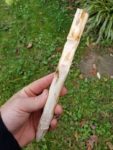
While I’d greatly prefer a real whittling knife for these kinds of projects, a test of this hatchet’s dexterity and ease of use is in order, so I’ve whittled a nice tent stake here using only the Estwing.
The hatchet was heavy, cumbersome, and unwieldy, but it got the job done. As an added bonus I can use the Estwing to hammer the stake into the ground!
A Couple Little Tricks
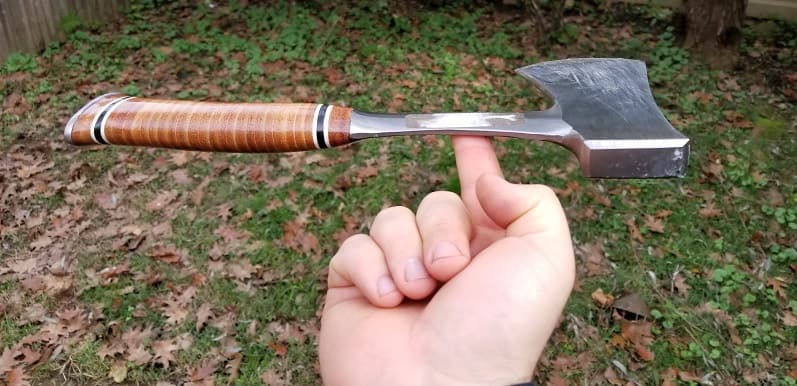
Remember I talked about the awkward balance of the Estwing? It’s actually perfectly balanced once you’re used to it, and that extra weight on the head is there to add some extra oomph to your swing. I can balance this hatchet easily on the edge of my finger.
Check out this ridiculously stupid flip test, as well; that sucker is balanced and falls right where I want it to!
“And it cuts through a tomato with ease!”
Well, that headline kind of spoils this one, but here we are.
My editor suggested the tomato slice with this hatchet and I’m happy to report the Estwing sliced through with ease, even after the bits of abuse I put it through.
Don’t worry, Paul, I’m going to mail you these tomato slices; just watch out for the wood chips!
Would I Buy It Again?
In a word, yes.
This hatchet has got some good weight, performs well, and has a durable construction. The little hang-ups I experienced will likely be ironed out with practice and with use.
I can’t wait to beat the heck out of this hatchet over the next six months. It’s going to be a fun getting-to-know-you, and I expect to have a far more thorough understanding and appreciation for what this hatchet is capable of.
Specs and Buying Options
Total Length: 14″ | Steel: 1055 Carbon Steel | Weight: 1.86lb | Made In USA
For more information on other axes and hatchets read our guide to the Best Survival Axe.




I am new to the world of axes, hatchets, survival stuff. Can you tell me when you would want to sharpen or signs that indicate to sharpen an Estwing hatchet? If you do need to sharpen it, what type of block would you need? Alanna
Experts can tell that their axe or hatchet needs sharpening when it starts being harder to use. A more sure-fire way of checking is to try to slice through a piece of paper with the axe. If it won’t slice, then it needs sharpening. A file is one of the easiest ways to sharpen but I personally prefer whetstones. They require more skill to use but give a better edge. If your hatchet was used improperly and has notches in the blade, you’ll need to do more serious sharpening and grind it down.
21 years ago I bought several Estwing hatchets and axes for the Boy Scout Troop that both of my Sons were in. The Estwing tools are still in use today by the latest generation of Scouts. If over twenty years of use and abuse by who knows how many 13 to 18 year old Scouts did not ruin them, then nothing will.
I’ve had my estwing for 35 years! I primarily use it for kindling and other camp tasks when I’m out in the woods. It handles everything I need it too and more. I’ve abused it and it just keeps going. Relatively easy to sharpen and decent edge retention make it a pretty low maintenance too. I love mine and short of leaving it behind somewhere I don’t think I’ll ever need to replace it. Love it!
The review is totally off about the ergonomic advantage of the hatchets full-tang design and it’s, “solid” feel. Estwing tools impart WAY more impact than a wood handled tool and that has been one drawback of them in industrial, long-term use every day on the job. Tendonitis. That said, it will be no problem for the even frequent user, and is designed to chop green wood anyway, not to split logs and build cabins.
Estwing is a gigantic tool company. I defy you to walk on any job site and not see Estwing tools in those boxes. Claw hammers, roofing axes, ball peen, sledge hammers, pry bars, etc. You probably an Estwing hammer with a blue rubber handle in a drawer somewhere. For all their products Estwing uses bar-grade 1060 (spring steel) and they buy way way way more of it than all the axe companies in Sweden combined. Estwing tools are machine forged, which is not inferior to hand forged, usually the opposite. The Swedes do go for a more knife-like hardness which makes them (1) sharper (2) hold an edge better (3) harder to sharpen. Truth is, if you get them knife sharp they will not hold THAT edge long whatsoever. Estwing settles for an RHC probably in the high 40s…45-48, which gets sharp eNOUGH and is easy to sharpen. Go read reviews on Gransfors Bruks hatchets and Estwing hatchets and see which has more complaints about factory flaws…
I’m not saying an E14A or E24A is preferable to a high-priced Swedish hatchet; I am merely saying it is a way way way better value for the $$$.
I look at Estwing hatchets like I look at housecats: if they weren’t around and suddenly appeared we’d appreciate them much more. To explain: If all we had were dogs and the next step was a bobcat and suddenly someone introduced the common housecat then they’d be selling for $10,000.00 and up. Likewise, if all we had were a choice between junky Coleman and Condor axes and Gransforth Bruks and Wetterlings for $150.00+ and Estwings suddenly came on the market with their high quality steel and manufacture for $35.00-$50.00 then people would understand the value they offer.
I have used one for more than 60 years. It has seen a lot of use and is still in good shape.
Can’t really say better than that Phil, this tool is practically bomb proof which makes it perfect for preppers.
I bought this hatchet as my first hatchet a few years ago and loved it from the first swing. I picked it up at a local hardware store and it came with the nice leather pouch. After a few winters of use this thing is an extension of my arm .
Ps geting rhe sticky off is no joke
Yeah we love this tool. I think Matt may even take it to bed with him at night 🙂